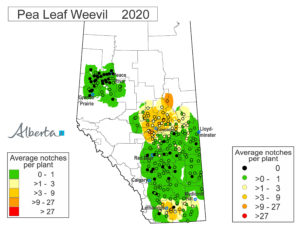Pea leaf weevil survey DEC 3 2020 | Producers | Agronomy and Blog Post
By Shelley Barkley, Insect Survey Technologist, Alberta Agriculture & Forestry
This is not a forecast for 2021, but a summary of the pea leaf weevil situation in the spring of 2020.
The annual pea leaf weevil (Sitona lineatus L.) survey was completed in late May and early June, 2020. The survey was based on damage ratings in 237 fields from 58 municipalities.
In each field, the total number of feeding notches per plant are counted on 10 plants in five locations near the field margin. The damage rating for a particular field is the average number of notches per plant. Although this survey concentrates on adult damage, yield losses are caused by the larval damage to the nitrogen fixing root nodules.
The highest damage ratings were around Edmonton. The population in southern Alberta remains at levels that could cause concern in random areas in the 2021. Numbers remain low in the Peace region, pea leaf weevil is established from southern Alberta through to the Peace. Survey locations shown with black circles had no evidence of pea leaf weevil feeding on any of the plants assessed.

Click here for a pdf of the map above.
While this is not a strict forecast, experience has shown us that activity levels greater than 9 notches per plant is sufficient to cause significant damage if spring conditions are favorable. This covers the irrigated area of southern Alberta and the region around Edmonton. For producers in these higher areas in 2020 there is a risk of damaging levels of pea leaf weevil in 2021. Producers should use this information along with their own experience to plan control strategies such as seed treatment for the 2021 crop year. Research has shown that seed treatment is much more effective in reducing losses from pea leaf weevil than foliar treatments.
Spring weather has an impact on the timing and severity of pea leaf weevil damage. When warm conditions (>20 C) persist for more than a few days in late April or early May the weevils arrive in fields early. Early weevil arrival corresponds to the potential for higher yield losses. In years where cool weather persists, the arrival of weevil can be much later; the resulting yield impact is lower especially when the crop advances past the 6-node stage before weevils arrive. Control decisions should be made on a field-by-field basis.
Since 2014 significant pea leaf weevil damage has been seen on faba beans in a much larger area than shown in this survey that is conducted on field peas. This insect causes as much or more damage on faba beans. The true economic damage of this insect on both peas and faba beans on the higher organic matter soils of central Alberta is not well understood, but research has been initiated to work out these relationships.
Thank you to Janet Lepp, Alberta Agriculture and Forestry for managing the data. Thank you to Raquel Neeser-Carazo and Brennan Folkerts, Alberta Agriculture and Forestry, for your contribution to the survey. Thank you David Giffen, Agriculture and Agri-Food Canada, Saskatoon for building the map.
For information about the pea leaf weevil and its life cycle click here.
Click here to see the range expansion of pea leaf weevil.
